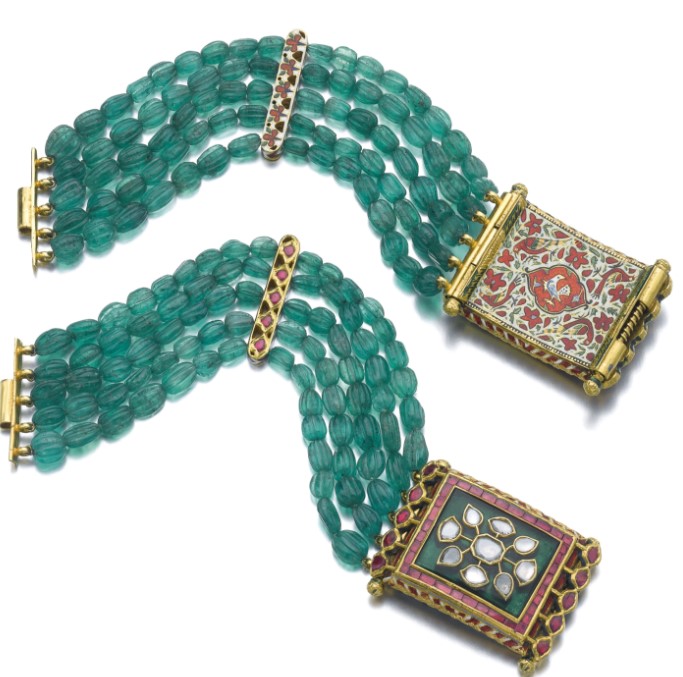March 2024 saw the opening of The Museum of Meenakari heritage which illustrates India’s enamel history at Jaipur. Curated by renowned jewellery historian, Dr. Usha Balakrishnan, this one-of-a-kind museum is an undertaking by the Designer Sunita Shekhawat to collect and present and preserve the history of meenakari in India. In this context, I want to shine light on this exquisite jewellery making technique by discussing the various meenakari colours and techniques used.
What is Meenakari
Meenakari or Minakari is the Persian technique of vitreous enamelling practised in India since the 16th century. Meena means paradise and kari means work. Raja Mann Singh of Amber, Rajasthan is credited with bringing the craft to India. Over the years, the word meena has become synonymous with enamel that even cold enamelling and using of enamel paint in jewellery are described in the market as “meena work.” Apart from jewellery, meenakari is also done on trinket boxes, swords, utensils, collectibles and more.

For the wearer’s eye
Meenakari is typically done on the reverse of a kundan piece to add value to it. Such ornamentation is meant only for the wearer’s eye. It is not for display. You can see one such stunning example above and another in the featured image of this post where the reverse of the box clasp is enamelled. Image from Sotheby’s.

However, meenakari can be present on the front of an object or on both sides as well. In such cases, you will see different narratives on different sides. In the necklace below the front is done up with images of the Sun God and the reverse is decorated with flowers. This also makes the piece double sided, to be worn by the wearer as they choose.

Making of Meenakari jewellery
Traditionally, Meenakari is champlevé enamelling. However, basse-taille enamelling is also used where the jewellery item is enamelled on both sides. In champlevé, the base metal is engraved to create channels or troughs which can be filled with the powder of crushed glass stones and fired in a kiln. This process is repeated until all the colours have been added. Watch the two videos that show the process in detail.
While the video above presents a modern style of making enamelled components, the one below presents a more traditional style.

Meenakari colours
While India is most known for its polychrome enamel – Panchrangi (multiple colours on a white base), the monochrome enamel – Partajikam is equally famous. A gold base can show off most colours, silver can only support pink, green and blue colours. Here is a short list of traditional meenakari colours.
White base – known as Safed Chalwan, these pieces have a white background on which birds or flowers and vines are depicted. This is reminiscent of the Deccani Enamelling work.
Green like a parrot’s wing – Tote-ka-par – This is a bright green that is used to depict leaves, vines, and parrots. It can commonly be seen in bangles with parrot head terminals. Enamellers of Southern India are also famous for their use of dark green colour monochrome enamel
Pigeon’s blood red – Khoon-e-kabouter – This is a jewel tone red that can be used as a monochrome enamel, as a base or in decorative forms.
Blue as the neck of a peacock – Gardan-e-taus – A dark sapphire blue which is all too common in costume jewellery, but rare to find in precious.
Light pink – Gulabi – Enamel that is reminiscent of pink blossoms is a trademark of the enamellers of Varnasi, Uttar Pradesh.
Transparent monochrome – Ek rang khula meena – you can see this in pastel colours such as light blue.
Bandh Meena – opaque enamel, surrounded by translucent enamel.

Forms in Meenakari jewellery
While flora and fauna are the most common motifs, you can also see human and divine forms (particularly those of Shrinathji) in the enamelled components. Unlike other types of traditional Indian jewellery, where text is uncommon, you can see text in meenakari jewellery.
With that we come to the end of this WIP post. I hope to visit the museum this year and will add more details to this post afterwards.
References and Further Reading
Balakrishnan, Usha. 2001. Jewels of the Nizams. Govt. of India.
___. 2014. Alamkara: The Beauty of Ornament. New Delhi: National Museum New Delhi.
Sharma, Rita Devi, and M. Varadarajan. 2008. Handcrafted Indian enamel jewellery. 2nd ed. Roli Books & Jansen BV.
I hope you find it interesting
Cheers



What do you think?